What is B2B SEO?
B2B (business-to-business) SEO is the focus on optimising a website to rank well in search engines, aiming to align with the specific needs, interests, and search behaviours of businesses seeking products, services, or solutions in a particular industry or niche.
Your B2B SEO should aim to drive qualified traffic to your website and increase the chances of converting that traffic into leads and customers. By using methods such as keyword research, content optimisation, technical SEO, link building, and analytics tracking to drive organic traffic, generate leads, and increase your businesses conversions.
What is the Difference Between B2B and B2C SEO?
B2B and B2C SEO both have unique differences which is important to understand when creating your SEO strategy. Broadly speaking, B2B SEO targets businesses and business professionals by focusing on industry specific keywords and technical solutions to complex business or industry problems. B2C on the other hand is only focused on consumers and showing product features while hitting the emotional triggers in their audiences.
Here is a summary of the differences between B2B and B2C SEO:
| B2B SEO | B2C SEO | |
|---|---|---|
| Target audience | Targets other businesses | Targets individual consumers |
| Decision makers | Purchase decisions are made by a small group within an organisation | Purchase decisions are made by individual consumers |
| Purchase decision process | Involve a longer, more complex sales process | Involve a shorter, less complex sales process |
| Keywords | Keywords related to products or services for other businesses | Keywords related to products or services for individual consumers |
| Content and messaging | Content and messaging may be more technical and focused on business benefits | Content and messaging may be more consumer-focused and emotional |
| Sales cycle | Sales cycles are typically longer | Sales cycles are typically shorter |
| Customer relationship | Customer relationships are often long-term and ongoing | Customer relationships are often shorter-term and transactional |
| Value of sale | Sales are often higher in value | Sales are often lower in value |
| Buying behaviour | Buying behaviour may be more analytical and research-driven | Buying behaviour may be more impulsive and influenced by emotions |
| Online presence | Prioritises professional and informative online presence | Prioritises user-friendly and aesthetically pleasing online presence |
8 Step B2B SEO Strategy:
Developing a B2B SEO strategy is crucial for businesses looking to stay ahead of the competition and increase their visibility in the digital world. Here is a step-by-step guide to creating a successful B2B SEO strategy in 2024:
1. Conduct keyword research:
The first step in any B2B SEO strategy is to identify the keywords that potential customers are using to search for products or services related to your business. There are many keyword research tools available, such as Google’s Keyword Planner and Ahrefs, that can help you identify the search volume and competition for specific keywords.
When conducting keyword research, be sure to focus on both high-volume and low-volume keywords. High-volume keywords are those that are searched for frequently, but may also be more competitive. Low-volume keywords, also called “long tail keywords,” are searched for less frequently but can still be valuable for driving qualified traffic to your website.
2. Identify your target audience:
In order to create an effective B2B SEO strategy, it is important to understand the needs and interests of your target audience. By creating buyer personas, or detailed profiles of your typical customers, you can better understand what types of content and services they are looking for.
3. Create a content calendar:
Once you have identified your target keywords and target audience, you can create a content calendar to plan out the types of content you will create, the topics you will cover, and the frequency of publishing. Be sure to include a mix of different types of content, such as blog posts, articles, videos, and infographics, to appeal to a wide range of search engine users.
4. Optimise on-page elements:
On-page optimisation refers to the process of optimising the content and HTML code of your website to improve its ranking in search engines. Some key on-page optimisation techniques involve:
- Creating high-quality, relevant content that addresses the needs and interests of your target audience
- Using header tags (H1, H2, etc.) to structure your content and signal to search engines the hierarchy of your content
- Including your target keywords in the title tags and meta descriptions of your website’s pages
- Using alt tags to describe images on your website
5. Conduct off-page SEO:
Off-page SEO is the process of building high-quality links from other websites to your website. These links are called backlinks. Search engines view backlinks as a vote of confidence in the quality and relevance of your website’s content. As such, building high-quality backlinks from reputable websites can help improve your search engine rankings and drive more qualified traffic to your website. Some ways to build backlinks include:
- Creating valuable, shareable content that other websites will want to link to
- Participating in industry forums and blogs and including a link to your website in your signature or bio
- Reaching out to other websites and offering to write a guest post or create a resource that they can link to
6. Use content marketing to attract and retain customers:
In addition to creating content to improve search engine rankings, you should use content marketing to attract and retain customers. This can include creating a blog, producing videos, or creating other forms of long-form content that addresses the needs and interests of your target audience. By providing valuable and informative content, you can build trust and credibility with potential customers and encourage them to do business with you.
7. Use technical SEO to improve the functionality of your website:
Technical SEO is about optimising the technical aspects of your website to improve its visibility and accessibility to search engines. This can include optimising page loading speed, ensuring that your website is mobile-friendly, using HTTPS, and using clean, descriptive URLs.
8. Measure and analyse results:
You must track your SEO efforts to see what is working and what is not. By using tools like Google Analytics, you can track your website’s traffic and conversions and use this data to refine your B2B SEO strategy. The key metrics to track include:
- Organic traffic: This is the traffic that comes to your website from search engines
- Conversion rate: This is the percentage of website visitors who take a desired action, such as filling out a form or making a purchase
- Keyword rankings: Track the ranking of your target keywords in search engine results to see how your optimisation efforts are paying off
In summary, a successful B2B SEO strategy should include:
- Conducting keyword research to identify target keywords and low-volume, long-tail keywords
- Identifying your target audience and creating buyer personas to understand their needs and interests
- Creating a content calendar and producing a variety of high-quality content types
- Optimising your on-page elements
- Conducting off-page SEO to improve your search engine rankings
- Using content marketing to attract and retain customers
- Implementing technical SEO to improve the functionality of your website
- Measuring and analysing results to refine and optimise your strategy
By following these steps and continually optimising and refining your B2B SEO strategy, you can drive more qualified traffic to your website and improve your search engine rankings. This will ultimately help you grow your business and reach more potential customers online.
What are the B2B SEO Strategy Best Practices?
B2B SEO is an effective way for businesses to increase their online visibility, generate leads, and drive sales. We’ve already talked about the importance of creating buyer personas and conducting keyword research.
But in order to come up with the best strategy for your business, you must consider other factors. Here are the best practices for creating a B2B SEO Strategy:
1. Create high-quality content:
Using your target keywords, create blog posts, articles, videos, and other forms of content that answer questions or concerns that your target audience has. Be sure to use header tags and naturally include your target keywords.
2. Use Google Analytics:
Google Analytics is a valuable tool to track the performance of your content and identify what is working and what is not. Use this data to refine your SEO strategy and create more high-performing content.
3. Create long-form content:
Long-form content, such as articles and blog posts, is a powerful way to attract and retain customers. Use your target keywords to create in-depth content that addresses the pain points, needs and interests of your target audience.
4. Use video content:
Video content can be an effective way to engage with potential customers and improve your search engine rankings. Utilise your keyword research to identify the topics and questions your target audience is searching for and create videos that provide valuable answers and insights.
5. Build backlinks:
By building high-quality backlinks from other websites to your own, you can improve your search engine rankings and drive more qualified traffic to your website. Create valuable, shareable content using your target keywords so that other websites will want to link to your blogs.
6. Focus on services pages:
Services pages are a key component of any B2B website. You should always have what you learnt from your keyword research in mind when creating detailed, informative pages that describe the products or services that you offer to other businesses.
7. Use related keywords:
In addition to your target keywords, consider using related keywords to attract a wider range of search engine users. By using a mix of different keywords, you can improve your search engine rankings, reach a wider audience and therefore attract new potential customers.
By following these best practices, you can create a comprehensive B2B SEO strategy that will help you grow your business and reach more potential customers online.
What is Search Intent?
Search intent, also known as “user intent,” refers to the purpose behind a search query. Understanding the search intent behind a particular set of keywords can help a B2B company create more relevant and effective content for other businesses and ultimately improve its search engine rankings.
Several different types of search intent are relevant to B2B companies:
1. Informational:
This type of search intent means that the user is looking for information on a particular topic related to the products or services that the B2B company provides to other businesses. They may be looking to learn more about a subject or to find answers to a specific question.
2. Navigational:
Navigational intent indicates that the user is searching for a specific website or web page related to your products or services. They might want to visit a particular website or find a specific page on a website.
3. Transactional:
This intent shows that the user is looking to make a purchase or to complete a specific action related to the products or services that your company provides to other businesses.
4. Commercial investigation:
A commercial investigation is when the user is in the early stages of the buying process and is considering their options before making a purchase. They may be researching different products or services, or comparing prices and features.
To define search intent for a particular set of keywords, a B2B company should try to understand the purpose behind the search. Are users simply looking for information, trying to find a specific website or page, looking to make a purchase, or considering their options before buying a product? Understanding the search intent behind a set of keywords allows a B2B company to create more relevant and effective content that meets the needs of other businesses.
How can Local SEO & How Geography help your SEO?
Local SEO focuses on optimising your online presence so you appear more frequently in local search results. This is particularly relevant for businesses with services or products made specifically for local audiences or businesses looking to target certain local demographics in their campaigns. You can accomplish this by having geographical information on your website content, meta tags, business listings, and citations. Capitalising on your local geography can provide more high quality, qualified leads for your business in targeted regions.
The SEO differences between blog and landing pages.
Firstly, blogs are usually made to provide information and and value to readers on many topics, interesting subjects and pain points. This means blogs will naturally target many keywords and aim to gather traffic organically through entertaining, educational content. In complete contrast, are specifically made to convert leads. Which will mean having concise and persuasive copy, clear CTA’s and no distractions on the page such as lead magnets. These differences are important to note in SEO.
SEO Errors to watch out for
Let’s cover the different errors you should stay mindful of when analysing your own businesses SEO activity. Like anything in marketing your business it takes more than just doing the work, we need to maintain what we’ve built up. Watching out for errors and construction reports on your SEO is what will keep your page ranking in SERP’s.
Understanding 404 Error Pages in SEO
Having 404 errors can negatively impact your impression on viewers as your content is leading them to digital dead ends. Having 404 error pages will negatively impact impressions, viewer retention and conversions for your site. The last thing you want is your site confusing and frustrating viewers. This will only result in users diverting away from your site.
Mentioning your core web vitals reports
Monitoring and optimising your Core Web Vitals report in SEO involves tracking key metrics like Largest Contentful Paint (LCP), First Input Delay (FID), and Cumulative Layout Shift (CLS) to improve website performance and user experience, ultimately enhancing search engine rankings and user satisfaction.
SEO KPI’s you should know!
Knowing your own numbers is crucial for successful SEO which is why KPIs are essential for SEO. This is because they provide measurable benchmarks for tracking performance, guiding optimisation strategies, and ensuring alignment with business objectives. Let’s cover them in more detail…
Traffic Volume:
This KPI measures the total amount of traffic your website receives from search engines and other sources. It indicates the overall visibility and reach of your website.
Traffic Sources:
Traffic sources show where your website visitors are coming from, such as organic search, direct traffic, referrals, social media, or paid advertising. Understanding traffic sources helps you identify which channels are driving the most visitors to your site.
Inbound Leads:
Inbound leads refers to the number of leads or inquiries generated from your website’s organic or paid traffic. It helps evaluate the effectiveness of your SEO efforts in generating potential customers.
Sessions per User:
Sessions per user measures the average number of times a user visits your website within a specific period. It provides insights into user engagement and the effectiveness of your content in encouraging return visits.
Average Session Duration:
Average session duration indicates the average amount of time visitors spend on your website during each session. It reflects the level of engagement with your content and the quality of user experience.
Page Impressions:
Page impressions, also known as page views, is the total number of times a page on your website is viewed by visitors. It helps assess the popularity and relevance of your website content.
Click-Through Rate (CTR):
Click-Through rates measures the percentage of users who click on a specific link or ad compared to the total number of users who viewed the link. It’s commonly used to evaluate the effectiveness of title tags, meta descriptions, and ad copy in attracting clicks.
Bounce Rate:
Bounce rate indicates the percentage of visitors who leave your website after viewing only one page without interacting further. A high bounce rate may suggest that visitors aren’t finding what they’re looking for or that there are issues with the website’s usability or content.
Goal Conversion Rate:
Goal conversion rates measures the percentage of visitors who complete a specific goal or desired action on your website, such as making a purchase, filling out a form, or signing up for a newsletter. It helps evaluate the effectiveness of your website in driving desired outcomes.
SEO Audits and everything you need to know about them.
Audits are super important for SEO! This is because they provide insights into website performance, identify areas for improvement, and enable strategic optimisation efforts to enhance visibility, user experience, and search engine rankings.
Backlink Audit:
Backlink audits involves analysing the quality and relevance of inbound links pointing to your website, identifying toxic or spammy links, and strategising to acquire high-quality backlinks that enhance your website’s authority and credibility in the eyes of search engines.
URL Canonicals Audit:
A URL canonicals audit ensures that canonical tags are correctly implemented across your website to resolve duplicate content issues and strengthen your link equity. It involves identifying instances where multiple URLs point to the same content and setting the canonical tag to indicate the preferred version, thereby improving crawl efficiency and search engine rankings.
Mobile Friendliness Audit:
A mobile friendliness audit assesses how well your website performs and displays on mobile devices, considering factors such as responsive design, page load speed, and usability. Aiming to ensure your website provides an optimal user experience across different screen sizes and devices. As mobile-friendliness is a crucial ranking factor in search engine algorithms, especially for B2B audiences who often access information on-the-go.
Use this Technical SEO Checklist
Here is a technical SEO checklist that you can use to ensure that your website is optimised to rank:
1. Check for crawl errors:
Use a tool like Google Search Console to identify crawl errors on your website, such as broken links or pages that are not being indexed.
2. Optimise page loading speed:
Page loading speed is a ranking factor for search engines. Tools like Google PageSpeed Insights help identify areas where you can improve your website’s loading speed.
3. Ensure that your website is mobile-friendly:
More and more people are accessing the internet from mobile devices, so it is important to ensure that your website is optimised for mobile. You can use Google’s Mobile-Friendly Test to check if your website is mobile-friendly.
4. Use HTTPS:
HTTPS (Hypertext Transfer Protocol Secure) is a secure version of HTTP, the protocol used to transfer data on the internet. Search engines give a ranking boost to websites that use HTTPS, so it is important to ensure that your website is using HTTPS.
5. Use clean, descriptive URLs:
You should include descriptive, keyword-rich URLs for your website’s pages. Avoid using long, confusing URLs with unnecessary parameters.
6. Use header tags:
Header tags (H1, H2, etc.) structure your content and make it easy for search engines to understand the hierarchy of your content.
7. Use alt tags to describe images:
Alt tags (alternative text) are used to describe images on your website. This is important for both accessibility and SEO, as search engines cannot “see” images and rely on alt tags to understand the content of images.
8. Use internal linking:
Use internal linking to help search engines understand the structure and hierarchy of your website’s content and to help users navigate your website.
9. Use schema markup:
Schema markup is a type of code that you can add to your website to help search engines understand the content and context of your pages. Using schema markup can help improve your search engine rankings and the way your website’s pages appear in search results.
10. Use a sitemap:
A sitemap is a file that lists all the pages on your website and helps search engines understand the structure and hierarchy of your content. Submitting a sitemap to search engines can help improve the indexing of your website’s pages.
Overall, a good SEO content strategy should be focused on creating valuable and relevant content that meets the needs of your target audience and helps improve your search engine rankings.
Let’s take the next step together…
With your checklist complete it’s time to take action! Now you know how to complete SEO for your business, lets get busy with base one in marketing.. Strategy! Lucky for you, we love variety here at Munro. So check out our 17 B2B marketing strategies blog, it’s packed with all the necessary knowledge to construct a strategy, perfect for your business.

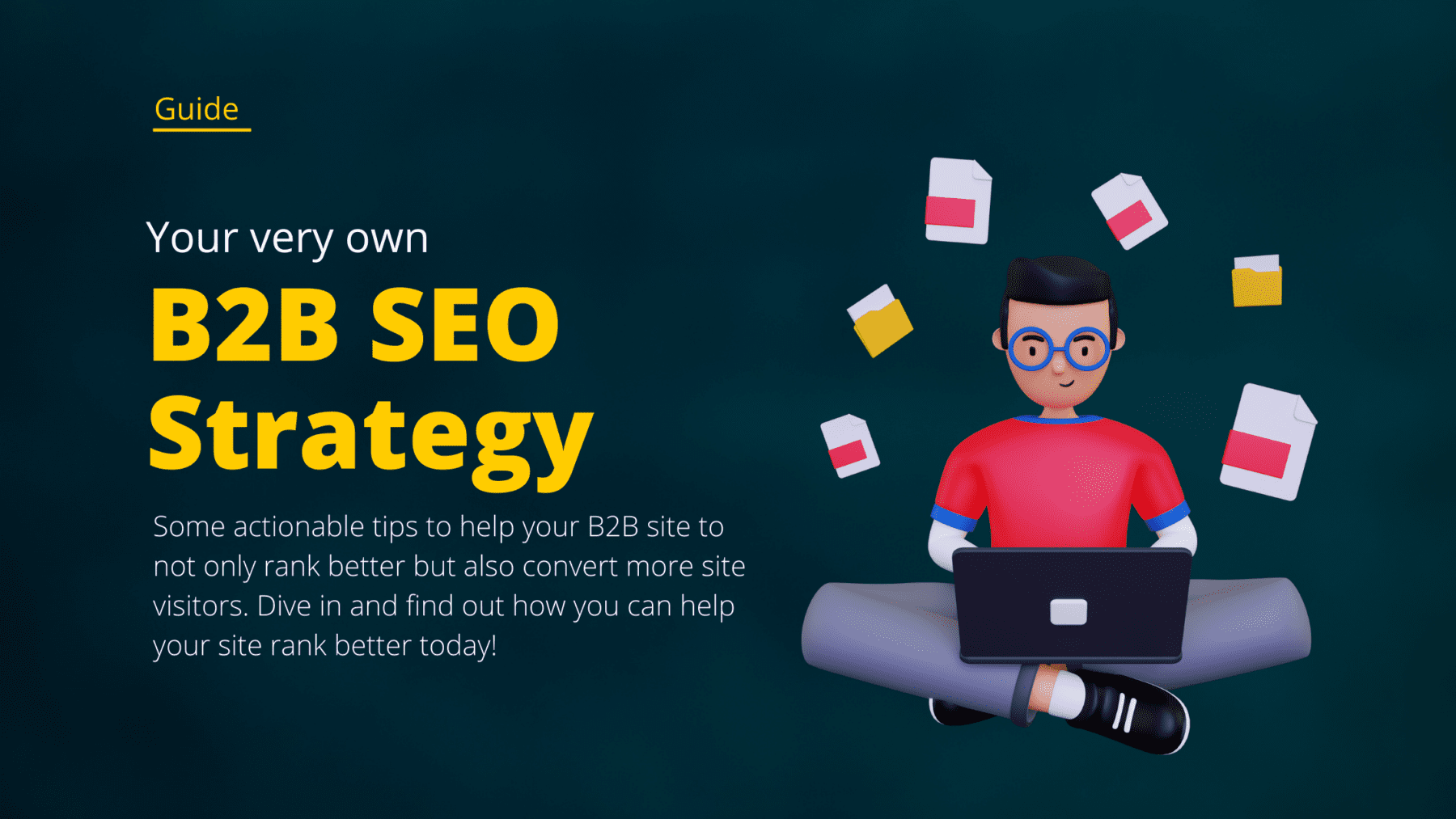
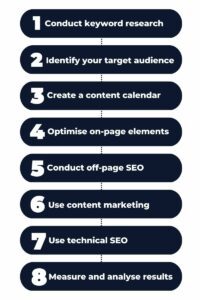
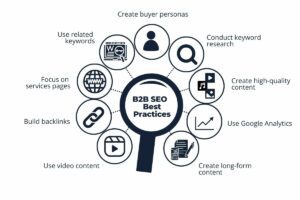
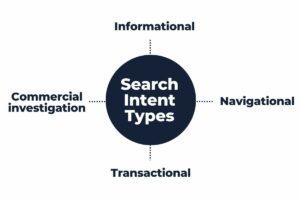



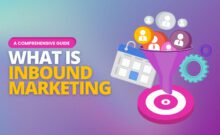




Leave a Comment